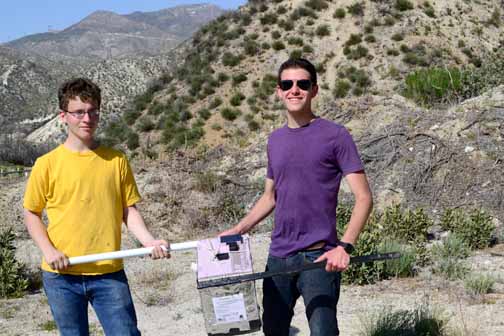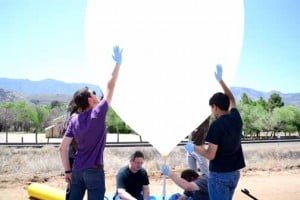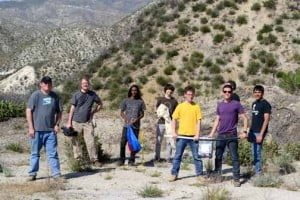
On April 28, five students from Clark Magnet High School launched a near-space balloon, labeled the Panther 2, from Acton. The project was a collaboration between two 12th grade students, Guy Burstein and Alex Deravanessian, for their Clark senior project. Working with them were three 11th grade students, Christopher Pereira, Saikiran Ramanan, and Matej Zampach of the advanced engineering class, with engineering instructor David Black. Two additional mentors assisted.
This project measured and analyzed solar and alternative energy. A detailed analysis of the results will be demonstrated at the two students’ senior projects.
The first launch with Panther 1 payload took place on May 26, 2012 from Simi Valley with a landing in Victorville. Peak altitude of 103,126 feet was reached.
This year’s payload featured three high-definition cameras, two temperature sensors, a photovoltaic panel, a carbon monoxide sensor, a three-axis accelerometer and magnetometer, onboard data logging, Global Positioning System(GPS) locator, radio transmitter, and GPS locator with satellite uplink. Panther 2 reached a peak altitude of 85,000 feet (over 16 miles). While lower than last year’s peak altitude, the flight still captured breathtaking photos of the Angeles National Forest, the California coast, the Crescenta Valley and Glendale, and the curvature of Earth against a black sky. The payload landed at Angeles National Forest.
“This was unbelievable and the best experience ever!” said Burstein.
“This was the most amazing and fun experience!” added Deravanessian.

Over the next several weeks, students will be analyzing the photos, videos, and over 5,000 samples of scientific data logged onboard to perform studies on the balloon’s performance, and environmental studies on atmospheric conditions and recovery of the Angeles National Forest after the devastating 2009 Station Fire. Photos and video will be compared to last year’s flight over the same region to understand the impact of Southern California drought conditions on recovery of the Station Fire burn area in the Angeles National Forest. Readings from an onboard carbon monoxide sensor will be used to determine if smog from the Greater Los Angeles area is found over the Angeles National Forest at higher altitudes. Acceleration data will be used to improve the descent characteristics of next year’s planned launch of the Panther 3.
This project was considered a success and will be used by many, including Clark’s engineering and other departments, as a measuring tool for scientific projects.
Submitted by Shakeh DERAVANESSIAN

